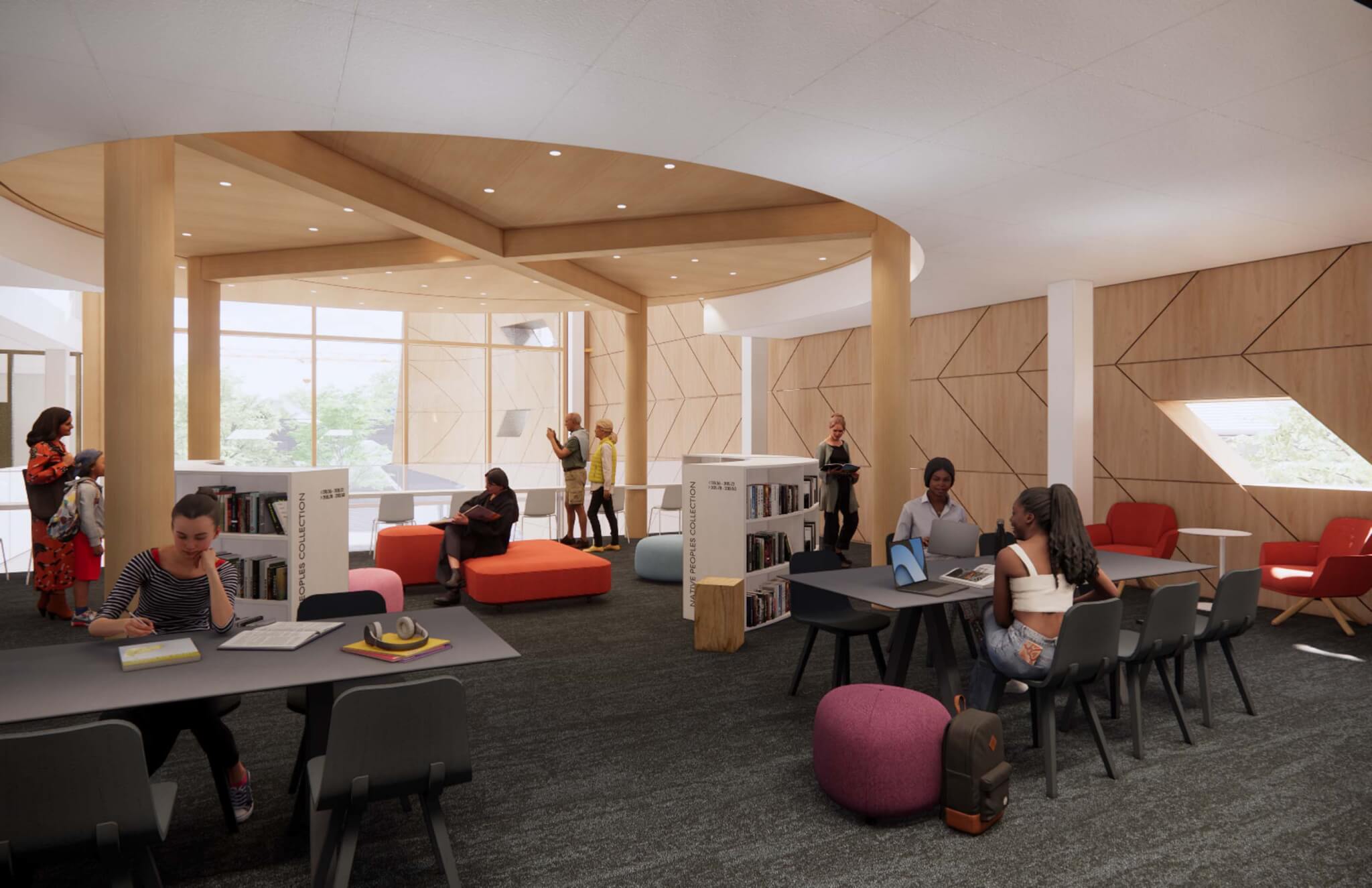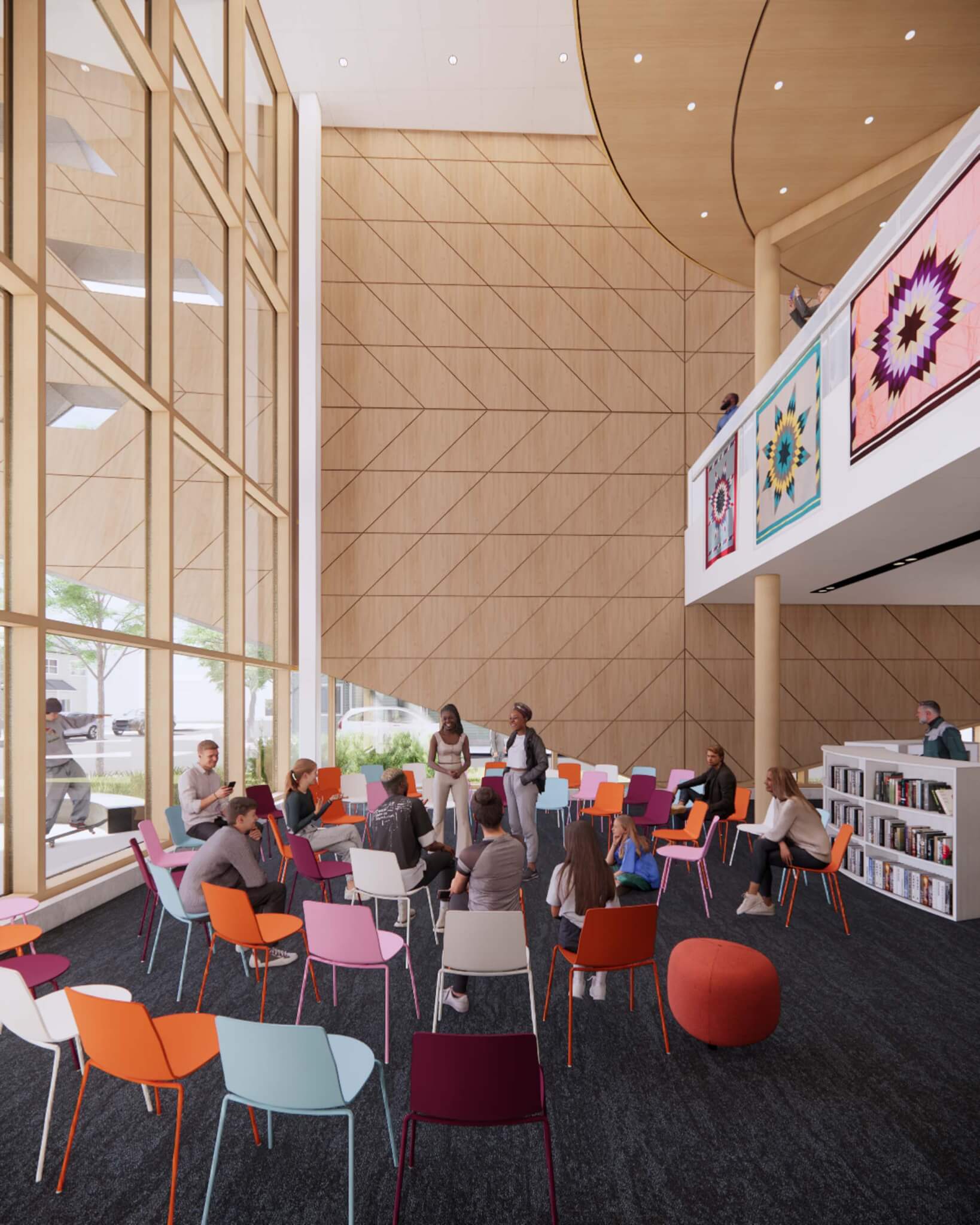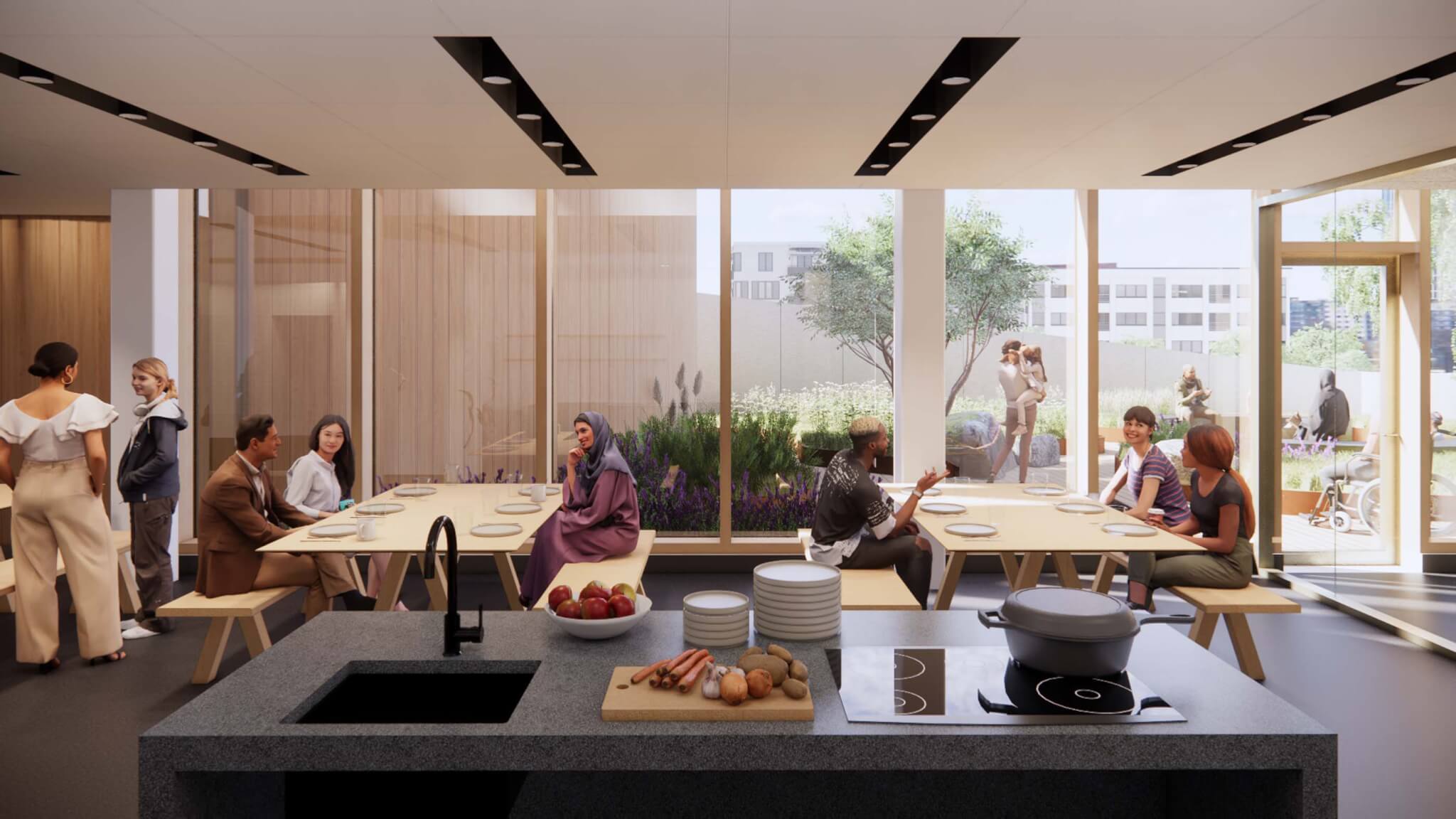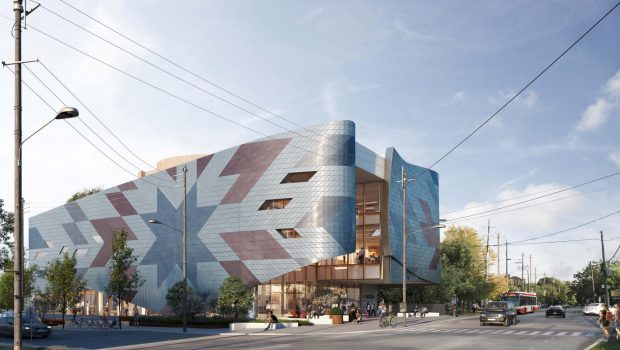Toronto library will weave Indigenous customs with technology
In Toronto’s Woodbine Gardens neighborhood, a new library and community center will provide resources for those who call the area home today while simultaneously honoring the traditions, heritage, and precedent of those who rightfully own the land upon which it stands. Rising three stories, the new building promises something special for a wearied, residential neighborhood marked by disjointed building scales and a diverse population. Indigenous- and woman-owned firm Smoke Architecture and Perkins&Will’s Toronto office collaborated on the project, which modernizes typologies from Indigenous architecture and couples them with technology and building materials to design a new, net-zero landmark.
Located on Dawes Road between Chapman Avenue and Brenton Street in eastern Toronto, the Dawes Road Library and Community Hub will occupy a tight footprint and replace the unassuming, existing brick library, enlarging it from 6,700 square feet to 26,300 square feet. It is one of 100 locations within the Toronto Public Library (TPL) network and the first branch to house both a library and community center under one roof, as well as the first in the system to be constructed under the Truth and Reconciliation mandate and commission, formed in response to the legacy of the Indian Residential School system.
The building’s location is within the Treaty lands and territory of the Mississaugas of the Credit First Nation and the traditional territory of Anishinaabeg, Haudenosaunee, and Huron-Wendat nations. Accurate census data on Indigenous peoples is sparse, but according to the City of Toronto and agencies serving Indigenous communities, there are an estimated 70,000 Indigenous residents in the city.
Since first contact between Indigenous peoples and European settlers and continuing after the establishment of the Residential Schools, there had been an erasure of Native belief systems and cultures from mainstream societal practices. With recent news condemning the operation of Residential Schools across Canada and with the formation of the Truth and Reconciliation Commission, Canadians from all backgrounds have become more aware of the teachings and customs of those whose land they occupy.
“We haven’t had Indigenous peoples as part of our awareness up until very, very recently, in fact, I think we were kind of persuaded into believing that Indigenous knowledge systems had died, and they have not, they’re very much alive,” Smoke Architecture founder and Principal Architect Eladia Smoke told AN. “There are still elders who hold these knowledge systems, but we have to support them in their good work to convey that knowledge to the next generations before they pass on themselves. So it’s a really critical time to do that work and to support that work to happen. And I think there’s a thirst for this stuff from mainstream Canadians to find out what we’ve been missing.”
Each TPL outpost uses a 10-year capital plan that establishes regular updates. Work on the Dawes Road branch started in 2008, and in 2017 it was decided to replace the existing building with a new facility. Design work by the project team began during the pandemic.
The current library is undersized for the community it serves, which has been identified by the city as a neighborhood improvement area in need of additional services and support facilities. While a public library is inherently a communal space, the building will offer a new breadth and scope of services and outreach to the demographically diverse community in a 5,500-square-foot community center thanks to a partnership with the City of Toronto Social Development, Finance & Administration. Among these offerings are study spaces, counseling rooms, teaching kitchens, and event and performance venues.

Perkins&Will and Smoke Architecture were selected to design the project from a competitive procurement call put out by TPL. While the two firms had never previously collaborated, they built off one another’s strengths, inputs, and insights throughout the design process. Perkins&Will brought expertise on technology and sustainability to the table as well as experience working with TPL, while Smoke brought architectural experience built on a deep understanding of Indigenous knowledge. Perkins&Will Design Director and Principal Andrew Frontini described this working relationship as “journey of discovery, where we’re going into an aesthetic territory where we don’t usually go, and [Smoke] going into a kind of technical arena, where it hasn’t been before. But the partnership allowed it to kind of happen, so it’s like this two-way street of learning.”
The design started from the concept of an Anishinaabe Roundhouse and Haudenosaunee Longhouse. (Smoke herself is Anishinaabekwe from Obishikokaang/Lac Seul First Nation.) Circular in form and shape, the Roundhouse is traditionally used as a place for gathering and sharing of knowledge, a theme that is intrinsically tied to the library and community center’s function. A Longhouse is a rectangular volume, similarly constructed using raw materials, that serves as both a residence and exchange of knowledge and traditions. Passive and sustainable practices and the use of raw building materials—used for generations by Indigenous peoples—are being used in contemporary design as architects find solutions to minimize the environmental impacts of building construction.
“There’s a shifting in perspective for us, and picking up the occupations that architects dealt with for thousands of years, but are new again for us,” Frontini added.
Coupling Native-informed typologies and building strategies with 21st-century requirements and amenities was a challenge, as historic Indigenous structures aren’t made to accommodate hundreds of people and don’t have mechanical heating and cooling systems. Striking a balance between the two was integral to the project from the start; it had to accommodate and respect the needs of both applications.

“We don’t want to create this sort of pan-Indigenous construction,” Susan Martin, manager of capital planning and implementation with the TPL, told AN. “Our idea is that in representing different features of Indigenous architecture and Indigenous ways of building and being in a space that will identify those spaces as unique elements—that the Roundhouse belongs to this community and the idea of a platform construction belongs to a different community—so that we’re not just creating this fusion, because that’s not really an appropriate way to go forward.”
The tessellating pattern across the facade is one way in which heritage and tradition is balanced with high-tech modernity. It pulls from another community-oriented Indigenous practice: the star blanket, a fabric covering traditionally gifted to a community member in recognition of the service they are doing for their community.
“Gifting of a star blanket has to do with community coming together,” Smoke explained. “The making of a star blanket is a very special undertaking. Even making one is sort of an honor for the maker. Gifting a star blanket represents wrapping the attention of our ancestors, who are now stars, around a person who’s doing excellent work in their community.”
“We anticipate the library is where the neighborhood will come together to do really important work together,” she continued. “And so the star blanket honors that work.”

The gifted objects are traditionally woven, but for this project durable zinc panels will be arranged across the facade in a quilt-like layout. Finalizing the pattern involved a meticulous technological process overseen by Perkins&Will. The designers began by exploring the shape of the blanket at a sculptural level and then scanned this using the LiDAR application to create and refine the digital model in Revit, which will be used by the facade manufacturers and installers during construction. The design team worked in tandem with custom facade engineering firm Zahner on the design.
On the inside of the structure, the walls will be wrapped in a warm-toned Prodema wood paneling arranged in a pattern to mimic the parallelogram shapes of the star pieces flanking the exterior shell. The metaphor of the star blanket as a gift of honor recognizing important work is complemented by that of a blanket’s thermal value as something warm and insulating. The building is designed to have an extremely tight envelope, and only about one third of the structure’s envelope is glazed. As for its heat and energy operations, it will be equipped with geothermal heat and photovoltaic roof panels. The project team anticipates net-zero operational carbon.

When the library opens in 2025 it will be be a place for gathering, learning, teaching, and sharing a meal. On the top of the Roundhouse, a rooftop garden will include a firepit around which the community can gather or ceremonies can be conducted. (A food preparation space and dining table offer another assembly place.) The entire project is conceived as a multi-use space while still offering visitors the expected books neatly stacked on the shelves and the requisite desks and chairs with which to enjoy them from.
“Libraries have always collected different formats and format changes over many years,” Martin said. “But the sort of central idea of the library being a place for the community to come together and share ideas, regardless of what the format that is in, is something that I think libraries have tried to do in stride. The challenge is always being able to provide ongoing access to the different formats over time. But that base idea of being able to provide access to information and a place to share knowledge is sort of in the constant, regardless of the format.”








Gloss